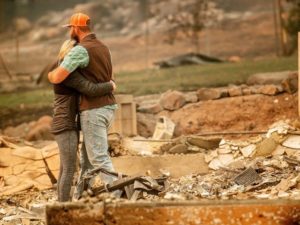After the Fires and Floods
This post originally appeared on November 16, 2018 on The Presidential Climate Action Project.

The people of Paradise, California, are going through a phase that virtually every community experiences after it is wiped out by a weather-related disaster. It is deciding whether to rebuild, where to rebuild, and how to rebuild smarter than it was.
In the process, Paradise and the other communities destroyed by weather can set examples for others as global climate change causes more severe fires, floods, hurricanes and sea-level rise.
Every disaster teaches hard lessons the hard way. Flooded communities discover, and in many cases rediscover, how vulnerable they are. If they are smart, they will rebuild away from floodplains, on higher ground if it’s available. Individual homes and businesses will probably make sure they have flood insurance in the future.
Communities leveled by hurricane-force winds learn to rebuild with more sturdy construction and roof tie-downs. Towns destroyed by tornadoes learn to incorporate shelters into their buildings, starting with schools, hospitals and homes.
For Paradise, where more than 50 people died and more than 8,000 homes and businesses were burned to the ground last week, local officials are planning to rebuild with greater clearances between buildings and trees, wider roads for evacuation, noncombustible building materials, stricter adherence to fire codes, and hardened infrastructure.
The most important lessons that communities like Paradise teach, however, is that we can no longer assume we are safe from extreme weather, coastal erosion or wildfires. The past is no longer prologue for our safety. The impacts of climate change are upon us. The old floodplain maps aren’t good aanymore The old tree clearances are insufficient to keep fire away from homes. Our old building codes are no longer good enough along the nation’s coasts or in tornado alley. We can deny that climate change is real if we wish, but that will not protect us from the fact that it is.
Because climate change is caused primarily by the use of fossil fuels, disaster-damaged communities can teach several other lessons as they recover. Buildings should incorporate the best available energy efficiency designs and equipment. New buildings should be oriented to the sun to take full advantage of rooftop solar systems. Contractors should use low-carbon concrete and steel. Landscaping should provide shade so that residents are protected from heat waves. Greenspaces, rooftop gardens and light-colored surfaces also help reduce inner-city temperatures. Parking lots and sidewalks can be made with permeable materials rather than asphalt and concrete. That allows them to absorb rains and reduce the chance of flooding.
In other words, communities should realize that what was smart yesterday may no longer be smart now.
We all should prepare for the fact that the weather is going to get much more severe than it already is because cars and power plants around the world are still dumping greenhouse gases into the atmosphere. Even if they were to stop today, the inertia of climate change will result in more extreme weather in the years ahead. Unfortunately, it appears right now that we will not stop polluting the atmosphere anytime soon. That must change.
This the world we have created for ourselves because we have known about climate change for a long time without doing much to stop it. Now we must learn the lessons that today’s weather is teaching us, adapt as best we can, and if we care about our children, spare them from a world that’s far more dangerous than it already is.
